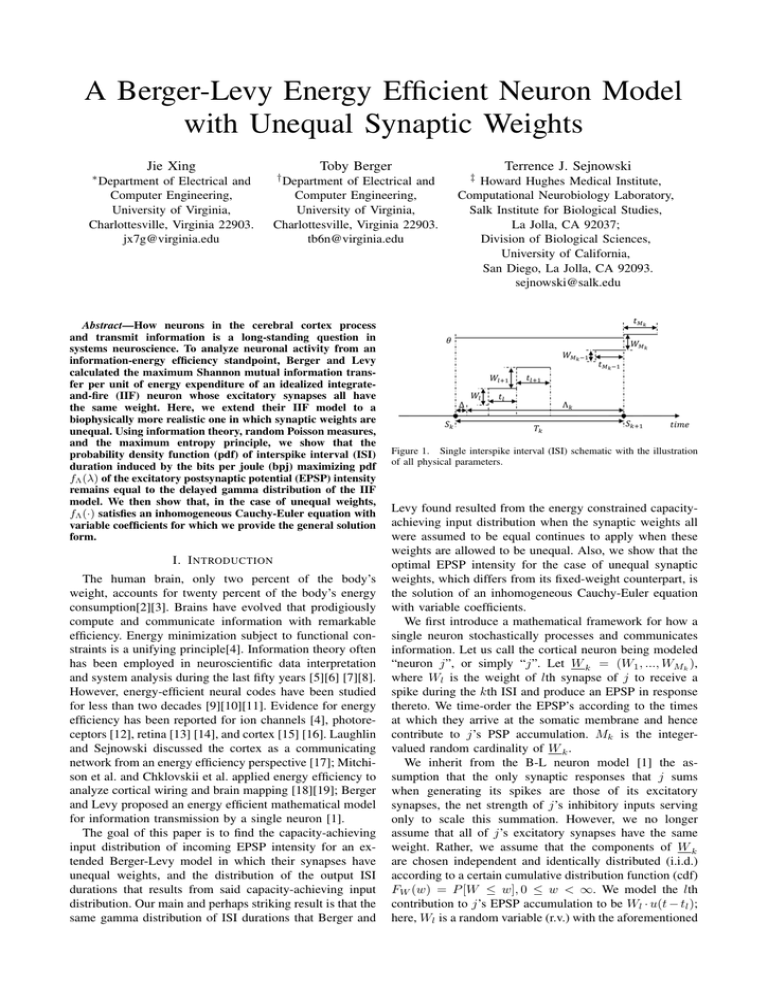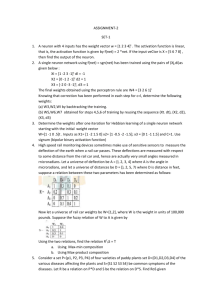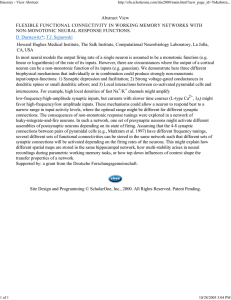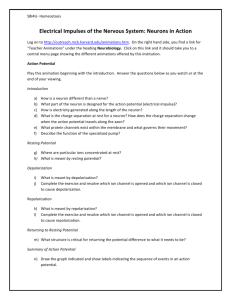A Berger-Levy Energy Efficient Neuron Model with Unequal Synaptic Weights Jie Xing
advertisement

A Berger-Levy Energy Efficient Neuron Model
with Unequal Synaptic Weights
Jie Xing
∗ Department
of Electrical and
Computer Engineering,
University of Virginia,
Charlottesville, Virginia 22903.
jx7g@virginia.edu
Terrence J. Sejnowski
Toby Berger
† Department
of Electrical and
Computer Engineering,
University of Virginia,
Charlottesville, Virginia 22903.
tb6n@virginia.edu
Abstract—How neurons in the cerebral cortex process
and transmit information is a long-standing question in
systems neuroscience. To analyze neuronal activity from an
information-energy efficiency standpoint, Berger and Levy
calculated the maximum Shannon mutual information transfer per unit of energy expenditure of an idealized integrateand-fire (IIF) neuron whose excitatory synapses all have
the same weight. Here, we extend their IIF model to a
biophysically more realistic one in which synaptic weights are
unequal. Using information theory, random Poisson measures,
and the maximum entropy principle, we show that the
probability density function (pdf) of interspike interval (ISI)
duration induced by the bits per joule (bpj) maximizing pdf
fΛ (λ) of the excitatory postsynaptic potential (EPSP) intensity
remains equal to the delayed gamma distribution of the IIF
model. We then show that, in the case of unequal weights,
fΛ (·) satisfies an inhomogeneous Cauchy-Euler equation with
variable coefficients for which we provide the general solution
form.
I. I NTRODUCTION
The human brain, only two percent of the body’s
weight, accounts for twenty percent of the body’s energy
consumption[2][3]. Brains have evolved that prodigiously
compute and communicate information with remarkable
efficiency. Energy minimization subject to functional constraints is a unifying principle[4]. Information theory often
has been employed in neuroscientific data interpretation
and system analysis during the last fifty years [5][6] [7][8].
However, energy-efficient neural codes have been studied
for less than two decades [9][10][11]. Evidence for energy
efficiency has been reported for ion channels [4], photoreceptors [12], retina [13] [14], and cortex [15] [16]. Laughlin
and Sejnowski discussed the cortex as a communicating
network from an energy efficiency perspective [17]; Mitchison et al. and Chklovskii et al. applied energy efficiency to
analyze cortical wiring and brain mapping [18][19]; Berger
and Levy proposed an energy efficient mathematical model
for information transmission by a single neuron [1].
The goal of this paper is to find the capacity-achieving
input distribution of incoming EPSP intensity for an extended Berger-Levy model in which their synapses have
unequal weights, and the distribution of the output ISI
durations that results from said capacity-achieving input
distribution. Our main and perhaps striking result is that the
same gamma distribution of ISI durations that Berger and
‡
Howard Hughes Medical Institute,
Computational Neurobiology Laboratory,
Salk Institute for Biological Studies,
La Jolla, CA 92037;
Division of Biological Sciences,
University of California,
San Diego, La Jolla, CA 92093.
sejnowski@salk.edu
Figure 1. Single interspike interval (ISI) schematic with the illustration
of all physical parameters.
Levy found resulted from the energy constrained capacityachieving input distribution when the synaptic weights all
were assumed to be equal continues to apply when these
weights are allowed to be unequal. Also, we show that the
optimal EPSP intensity for the case of unequal synaptic
weights, which differs from its fixed-weight counterpart, is
the solution of an inhomogeneous Cauchy-Euler equation
with variable coefficients.
We first introduce a mathematical framework for how a
single neuron stochastically processes and communicates
information. Let us call the cortical neuron being modeled
“neuron j”, or simply “j”. Let W k = (W1 , ..., WMk ),
where Wl is the weight of lth synapse of j to receive a
spike during the kth ISI and produce an EPSP in response
thereto. We time-order the EPSP’s according to the times
at which they arrive at the somatic membrane and hence
contribute to j’s PSP accumulation. Mk is the integervalued random cardinality of W k .
We inherit from the B-L neuron model [1] the assumption that the only synaptic responses that j sums
when generating its spikes are those of its excitatory
synapses, the net strength of j’s inhibitory inputs serving
only to scale this summation. However, we no longer
assume that all of j’s excitatory synapses have the same
weight. Rather, we assume that the components of W k
are chosen independent and identically distributed (i.i.d.)
according to a certain cumulative distribution function (cdf)
FW (w) = P [W ≤ w], 0 ≤ w < ∞. We model the lth
contribution to j’s EPSP accumulation to be Wl · u(t − tl );
here, Wl is a random variable (r.v.) with the aforementioned
cdf FW (w) and u(t − tl ) equals 1 for t ≥ tl and equals
0 for t < tl . We continue to assume as in [1] that each of
j’s refractory periods has the same duration, ∆. Since this
theoretical extension connects the plasticity of a neuron’s
synaptic weights, widely considered essential to learning
and memory, with the communication of information by the
neuron, it may possess considerable practical significance
[20].
Slightly differently from [1], we model the EPSP’s
produced in response to spikes from j’s afferent cohort
as an inhomogeneous Poisson measure with instantaneous
rate function, A(t), defined by
P [one EPSP arrival in(t, t + dt)]
.
(1)
dt
Then as in [1] we take a time average operation over the
rate function A(t) and obtain
Z Sk
1
Λk =
A(u)du,
(2)
Tk − ∆ Sk−1 +∆
A(t) := lim
dt→0
where ∆ is the duration of j’s refractory period, Tk is the
kth ISI duration of j and Sk = T1 + · · · + Tk .
Henceforth, we suppress the ISI index k and just write
W , M , T and Λ. Thus, when Λ = λ, EPSP’s are being
assumed to arrive according to a homogeneous Poisson
process with intensity λ.
Here we are interested in the Shannon mutual information, I(Λ; T ). Although this has been defined for a single
pair of r.v.’s Λ and T , it has been shown that it is a good
first-order approximation to the long term information in
bits per spike, namely
1
I(Λ1 , . . . , ΛN ; T1 , . . . , TN ),
(3)
N →∞ N
lacking only an information decrement that addresses correlation among successive Λi ’s; see [1].
Since T − ∆ is a one-to-one function of T , we have
I(Λ; T ) = I(Λ; T − ∆), which in turn is defined [21] [22]
as
"
#
fT −∆|Λ (T − ∆|Λ)
I(Λ; T − ∆) = E log
,
(4)
fT −∆ (T − ∆)
I := lim
where the expectation is taken with respect to the joint
distribution of Λ and T .
Toward determining I(Λ; T ), we proceed to analyze
fT −∆|Λ (t|λ) and fT −∆ (t) in cases with unequal synaptic
weights.
arithmetically averaged to obtain a population histogram
with fine resolution in the weights of its synaptic bins.
This, in turn, would permit one to approximate this fine
histogram by a continuous amplitude probability distribution of synaptic weights. (Then the analysis becomes
more widely applicable than if one were to have used the
exact weights of a particular neuron, especially considering
that even that neuron will have a different set of weights
in the future because of ongoing synaptic modification.)
Moreover, the strong similarity of the synaptic weight
distributions has been observed through experiments.[20]
Therefore, in the analysis that follows we take the view
that the components of W are selected randomly from
this continuous amplitude probability distribution. Said
random distribution of synaptic weights also incorporates
the random number of neurotransmitter-containing vesicles
that are released when a spike is afferent to the synapse,
the random number of neurotransmitter molecules in these
vesicles, how many of those cross the synaptic cleft, bind
to receptors and thereby generate EPSP’s.
This model of random selection of weights comprising
W is applicable both to ISI’s in which the afferent firing
rate Λ is large and to those in which it is small. When
the value λ assumed by Λ is large, W ’s components just
get selected more rapidly than when λ is small, but they
continue to come from the same distribution. This implies
that the expected number of them in a single ISI remains
the same. Hence, from now on, we assume that the weight
vector components W1 , ..., WM are jointly independent of
Λ.
III. F INDING fT −∆|Λ (t|λ): M IXTURES OF G AMMA
D ISTRIBUTIONS
We denote the spiking threshold by θ. The contribution
to j’s PSP accumulation attributable to the lth afferent
spike during an ISI will be assumed to be a randomly
weighted step function Wl · u(t − tl ), where tl is the time
at which it arrives at the postsynaptic membrane. 1
It follows that the probability Pm = P (M = m) that
exactly m PSP’s are afferent to j during an ISI is
Pm = P (W1 +· · ·+Wm−1 < θ, W1 +· · ·+Wm ≥ θ). (5)
Next, we write
P (t ≤ T − ∆ ≤ t + dt|Λ = λ)
∞
X
=
P (t ≤ T − ∆ ≤ t + dt, M = m|Λ = λ)
II. NATURE OF THE RANDOMNESS OF WEIGHT
VECTORS
Even if the excitatory synaptic weights of neuron j were
known, W = (W1 , ..., WM ) would still be random because
the time-ordered vector R of synapses excited during an ISI
is random. However, for purposes of mathematical analysis
of neuron behavior it is not fruitful to restrict attention to
a particular neuron with a known particular set of synaptic
weights. Rather, it is more useful to think in terms of the
histogram of the synaptic weight distributions of neurons in
whatever neural region is being investigated. When many
such histograms have been ascertained, if their shapes
almost all resemble one another closely, then they can be
=
m=1
∞
X
Pm · P (t ≤ T − ∆ ≤ t + dt|Λ = λ, M = m), (6)
m=1
where (6) holds because of the assumption that W =
(W1 , ..., WM ) is independent of Λ, which implies its
random cardinality, M , is independent of Λ.
1 In practice, u(t − t ) needs to be replaced by a g(t − t ), where g(·)
l
l
looks like u(·) for the first 15 or so ms but then begins to decay. This
has no effect when λ is large because the threshold is reached before
this decay ensues. For small-to-medium λ’s, it does have an effect but
that could be neutralized by allowing the threshold to fall with time in
an appropriate fashion. There are several ways to effectively decay the
threshold, one being to decrease the membrane conductance.
It follows as in [1] that, given M = m and Λ = λ, T −∆
is the sum of m i.i.d. exponential r.v.’s with parameter λ,
i.e., a gamma pdf with parameters m and λ. Summing
over all the possibilities of M and letting dt become
infinitesimally small, we obtain
∞
X
λm tm−1 e−λt
u(t).
fT −∆|Λ (t|λ) =
Pm ·
(m − 1)!
m=1
(7)
A. Case: Exponential Weight Distribution
Suppose the components of the weight vector are i.i.d.
and have the exponential pdf αe−αwi , wi ≥ 0 with α > 0.
Then we know that Ym := W1 + · · · + Wm has the
gamma pdf
m m−1 −αy
α y
e
(m − 1)!
u(y).
So, referring to (5), we have
0
(8)
Therefore, it follows from (7) that
∞
m−1
X
(αθ)
λm tm−1 e−λt
e−αθ ·
u(t)
fT −∆|Λ (t|λ) =
(m − 1)!
(m − 1)!
m=1
∞
k
X
(αθλt)
(9)
2 u(t).
(k!)
√
The summation in (9) equals I0 (2 αθλt) where I0 is
the modified Bessel function of the first kind with order
0 [23].
k=0
IV. T − ∆ IS G AMMA DISTRIBUTED
For the conditional pdf fT −∆|Λ (t|λ) as in (7), letting
X = λ(T − ∆), we have the following equality
in which x = λt. It follows, in view of (7), that
Pm ·
m=1
xm−1 e−x
, 0 ≤ x < ∞.
(m − 1)!
(10)
Note that λ not only doesn’t explicitly appear on the
right-hand side of Eq. (10) but also does not appear there
implicitly within any of the Pm ’s; this is because, as noted
earlier, M is independent of Λ, so Pm = P (M = m)
cannot be λ-dependent. Accordingly,
fX|Λ (x|λ) = fX (x) =
(13)
We see that (13) describes a channel with additive noise
that is independent of the channel input. Specifically, the
output is log(T − ∆), the input is − log Λ, and the additive
noise is N := log X, which is independent of Λ (and
therefore independent of − log Λ) because X and Λ are
independent of one another.
The mutual information between Λ and T − ∆ thus is
I(Λ; T − ∆) = I(log Λ; log(T − ∆))
= h(log(T − ∆)) − h(log(T − ∆)| log Λ)
= h(log(T − ∆)) − h(N ).
(14)
∞
X
m=1
Pm ·
h(log(T − ∆)) = −E[log(fT −∆ (T − ∆) · (T − ∆))]
= h(T − ∆) − E log (T − ∆).
(15)
Thus, after substituting Eq. (15) into Eq. (14) and adding
the information decrement term as in [1], the long term
average mutual information rate, I, we seek to maximize
over the choice of fΛ (·) is
I = h(T − ∆) − h(N ) + (κ − 1)E log (T − ∆) − C. (16)
Define T− := T − ∆; then Eq. (16) becomes
I = h(T− ) + (κ − 1)E log (T− ) − h(N ) − C.
(17)
Since N is independent of Λ, the choice of fΛ (·) affects I
in Eq. (17) only through fT− (·) via the following equation
Z ∞
dλfΛ (λ)fT− |Λ (t|λ) = fT− (t), 0 ≤ t < ∞. (18)
0
|fX|Λ (x|λ)dx| = |fT −∆|Λ (t|λ)dt|
∞
X
where X is marginally distributed according to Eq. (11).
Then by taking logarithms in Eq. (12), we have
Since fZ (z) = fT −∆ (t)|dt/dz| = fT −∆ (t) · t, it finally
follows that
(m−1)
(αθ)
e−αθ .
(m − 1)!
fX|Λ (x|λ) =
(12)
h(log(T − ∆)) = h(Z) = −E log fZ (Z).
θ−u
=λe−(αθ+λt)
1
· X,
Λ
Letting Z = log(T − ∆), we have
Pm =P (Ym−1 < θ, Wm ≥ θ − Ym−1 )
Z θ
Z ∞
=
fYm−1 (u)du
fWm (v)dv
=
T −∆=
log(T − ∆) = − log Λ + log X,
It is impossible to determine Pm in the general case.
However, we have been able to compute it exactly in the
special case of an exponential weight distribution.
fYm (ym ) =
Hence, although X equals Λ(T − ∆), X nonetheless is
independent of Λ. 2 We can rewrite the relationship as
xm−1 e−x
, x ≥ 0. (11)
(m − 1)!
Therefore, our bpj maximizing task has been reduced to
maximizing the entropy rate h(T ) subject to Lagrange
multiplier constraints on information decrement, E log T ,
and energy constraint ET which can be written as C0 (1 +
bT ) [1]. Taking C0 as the energy unit, we have b as the
coefficient of ET . It is known that the entropy h(T ) is
maximized subject to constraints on E log T and ET when
2 A simple example in which X = AB is independent of A may be
enlightening here. Let P (A = −1) = P (A = 1) = 1/2, P (B =
−2) = P (B = −1) = P (B = 1) = P (B = 2) = 1/4, and assume
A and B are independent. Note that, given either A = −1 or A = 1,
X is distributed uniformly over {−2, −1, 1, 2}, so X is independent of
A. X is not independent of B in this example because |B| = 2 implies
|X| = 2, whereas |B| = 1 implies |X| = 1. In our neuron model the
two factors of X, namely Λ and T − ∆, are not independent of one
another but rather are strongly negatively correlated.
T is a delayed gamma distribution with two parameters we
denote by κ and b, i.e.,
"
#
bκ tκ−1 e−bt
fT− (t) =
u(t),
(19)
Γ(κ)
which is the bpj-maximizing distribution of neuron j’s ISI
duration, T , sans its refractory period which always has
duration ∆.
V. F ROM THE I NTEGRAL E QUATION TO THE
D IFFERENTIAL E QUATION
1) The to-be-optimized pdf fΛ (λ) of the arithmetic
mean of the net afferent excitation of neuron j during
an ISI.
2) The conditional pdf fT− |Λ (t|λ) of j’s encoding of Λ
into the duration T of said ISI.
3) The long term pdf fT− (t) of j’s ISI duration.
Z ∞
dλfΛ (λ)fT− |Λ (t|λ) = fT− (t), 0 ≤ t < ∞. (20)
0
Moreover, we have
fT− |Λ (t|λ) =
m=1
Pm ·
λm tm−1 e−λt
,
(m − 1)!
(21)
and
#
bκ tκ−1 e−bt
fT− (t) =
u(t).
Γ(κ)
"
(22)
Let’s first consider a case in which Pm is nonzero only
for two consecutive values of m, say n and n + 1 with
respective probabilities Pn = p and Pn+1 = 1 − p := q. In
such a case
!
Z ∞
pλn tn−1
qλn+1 tn −λt
dλfΛ (λ)
+
e
= fT− (t).
(n − 1)!
n!
0
(23)
Substituting Eq. (22) into Eq. (23) and applying integration
by parts and inverse Laplace transform on Eq. (23), it
follows that
(1 + q/n)fΛ (λ) + (λq/n)fΛ0 (λ)
Γ(n)
=λ−n
bκ (λ − b)n−κ−1 u(λ − b).
Γ(κ)Γ(n − κ)
j=0 i=0
Pj+1
(j + 1)!
1
(j−i)
λ(j−i) fΛ
(λ)
(j − i + 1)! i!(j − i)!
(25)
bκ
λ−1 (λ − b)−κ u(λ − b).
=
Γ(κ)Γ(1 − κ)
Eq. (25) also has an analytical closed-form solution, which
serves as the bpj-maximizing pdf of neuron j’s averaged
afferent excitation intensity Λ.
VI. C ONCLUSION
The integral equation below relates the following three
quantities:
∞
X
j
n−1
XX
(24)
Eq. (24) constitutes a conversion of the integral equation (23) for the maximum-bpj excitation intensity fΛ (λ),
into a first-order linear differential equation. The differential equation has a λ-varying coefficient on its f 0 term.
Nonetheless, it has an explicit analytical solution because
there exists a general solution to any inhomogeneous firstorder linear differential equation with variable coefficients.
In general, Eq. (24) turns out to be an inhomogeneous
Cauchy-Euler equation with variable coefficients as Eq.
(25).
We have shown that, when neuron j is designed to
maximize bits conveyed per joule expended, even though
j’s synapses no longer are being required to all have the
same weight, the pdf of the ISI durations continues to be
exactly the same gamma pdf as it was in [1] wherein all the
weights were assumed to be equal. This happens despite
the fact that the conditional distribution for T given Λ is
now a mixture of gamma distributions instead of the pure
gamma distribution that characterizes the special case of
equal weights.
Additionally, we have implicitly determined the optimal
distribution fΛ (λ) that characterizes the afferent excitation
intensity by (1) maximizing the Shannon mutual information rate given a constraint on the total energy cost that
a cortical neuron expends for metabolism, postsynaptic
potential accumulation, and action potential generation and
propagation during one ISI; (2) converting the integral
equation to a differential equation with a closed-form
solution.
The energy efficiency of the human brain in terms of
information processing is astonishingly superior to that
of man-made machines. By extending the Berger-Levy
information-energy efficient neuron model to an unequal
synaptic weights case, the theory comes into closer correspondence with the actual neurophysiology of cortical
networks, which might pave the way to wider applications
in neuroscience and engineering.
R EFERENCES
[1] T. Berger and W. B. Levy, A mathematical theory of energy efficient
neural computation and communication, IEEE Trans. IT, vol. 56,
No. 2, pp. 852-874, February 2010.
[2] J. M. Kinney, H. N. Tucker, Clintec International Inc, Energy
Metabolism: Tissue Determinants and Cellular Corollaries (Raven,
New York), p xvi, 1992.
[3] L. C. Aiello, P. Wheeler, The expensive-tissue hypothesis–the brain
and the digestive-system in human and primate evolution, Curr
Anthropol 36:199-221,1995.
[4] A. Hasenstaub, S. Otte, E. Callaway, and T. J. Sejnowski, Metabolic
cost as a unifying principle governing neuronal biophysics, Proc
Natl Acad Sci USA 107: 12329-12334, 2010.
[5] D. M. MacKay, W. S. McCulloch, The limiting information capacity
of a neuronal link, Bulletin of Mathematical Biophysics, vol. 14,
127-135, 1952.
[6] W. S. McCulloch, An upper bound on the informational capacity
of a synapse, In Proceedings of the 1952 ACM national meeting,
Pittsburgh, Pennsylvania.
[7] R. R. de Ruyter van Steveninck, W. Bialek, Real-time performance
of a movement-sensitive neuron in the blowfly visual system: Coding
and information transfer in short spike sequences, Proceedings of
the Royal Society Series B, Biological Sciences, 234, 379-414,
1988.
[8] W. Bialek, F. R. Rieke, R. R. de Ruyter van Steveninck and
D. Warland, Reading a neural code, Science, 252,1854-7, 1991.
[9] W. B. Levy, R. A. Baxter, Energy efficient neural codes, Neural
Comput 8:531-543, 1996.
[10] W. B. Levy, R. A. Baxter, Energy-efficient neuronal computation via
quantal synaptic failures, J Neurosci 22:4746-4755, 2001.
[11] V. Balasubramanian, D. Kimber, M. J. Berry, Metabolically efficient
information processing, Neural Comput 13:799-815, 2001.
[12] J. E. Niven, I. C. Anderson, S. B. Laughlin, Fly photoreceptors
demonstrate energyinformation trade-offs in neural coding, PLoS
Biol 5:e116, 2007.
[13] V. Balasubramanian, M. J. Berry, A test of metabolically efficient
coding in the retina, Network 13:531-552, 2002.
[14] S. B. Laughlin, R. R. de Ruyter van Steveninck, J.C. Anderson, The
metabolic cost of neural information, Nat Neurosci 1:36-41, 1998.
[15] D. Attwell, S. B. Laughlin, An energy budget for signaling in the
grey matter of the brain, J Cereb Blood Flow Metab 21:1133-1145,
2001.
[16] B. D. Willmore, J. A. Mazer, J. L. Gallant, Sparse coding in
striate and extrastriate visual cortex, J Neurophysiol, 105(6):290719, 2011.
[17] S. B. Laughlin, T. J. Sejnowski, Communication in neuronal networks, Science 301:1870, 2003.
[18] G. Mitchison, Neuronal branching patterns and the economy of
cortical wiring, Proc Biol Sci 245:151-158, 1991.
[19] D. B. Chklovskii, A. A. Koulakov, Maps in the brain: What can we
learn from them, Annu Rev Neurosci 27:369-392, 2004.
[20] B. Barbour, N. Brunel, V. Hakim, J. Nadal, What can we learn
from synaptic weight distributions?, Trends Neurosci 30(12): 622629, 2007.
[21] T. Cover and J. Thomas, Elements of Information Theory, 2nd ed.
Hoboken, NJ: Wiley, 2006.
[22] R. G. Gallager, Information Theory and Reliable Communication,
New York: Wiley, 1968.
[23] I. S. Gradshteyn and I. M. Ryzhik, Table of Integrals, Series, and
Products, Edited by A. Jeffrey and D. Zwillinger. Academic Press,
New York, 7th edition, 8.447, p. 961, 2007.






